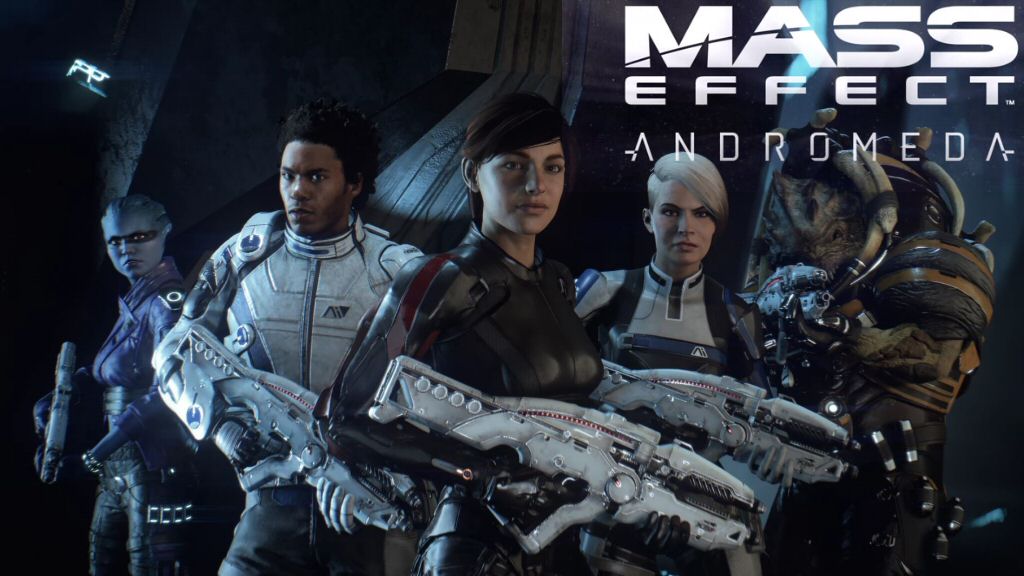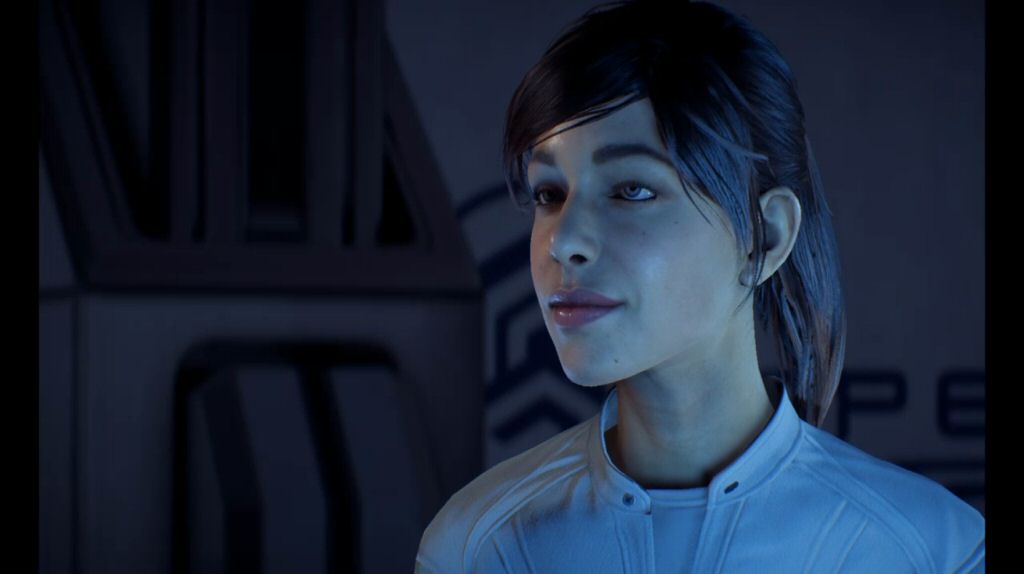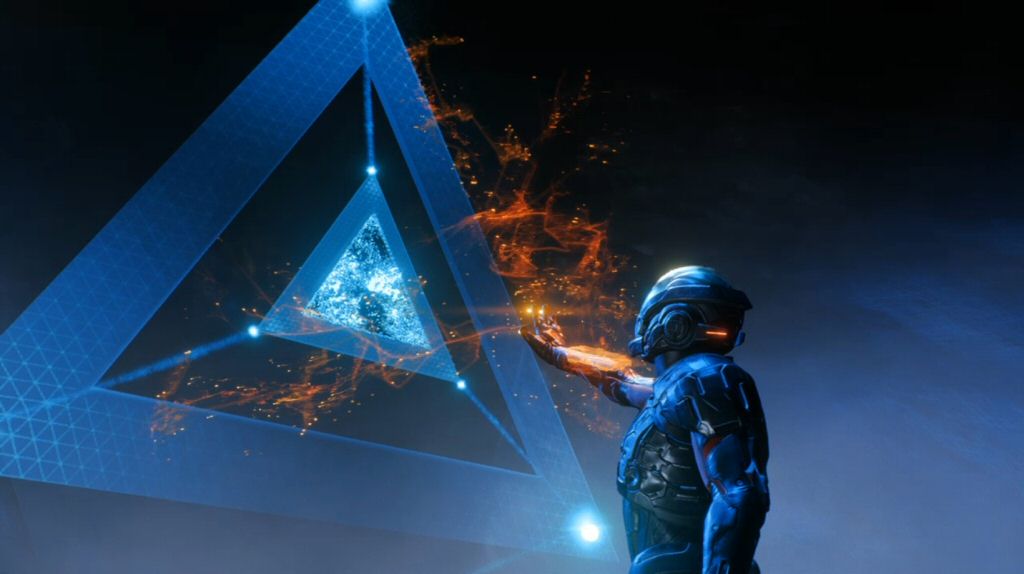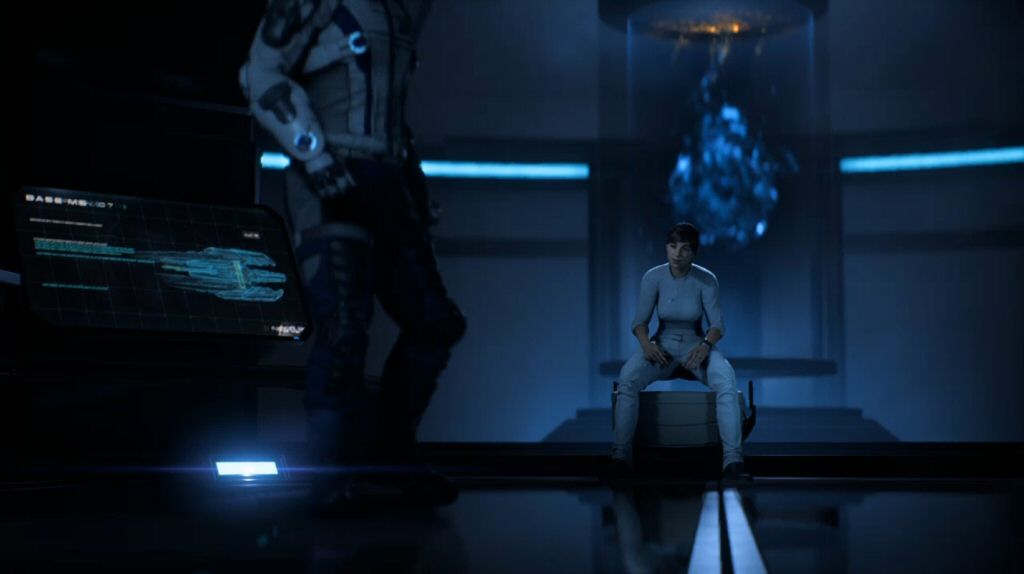Andromeda Part 5: The Pathfinder
Alec Ryder walks up to the alien machine and holds up his hand. A huge starmap(?) appears, along with an alien symbol. The electrical storm stops, the skies clear, and everything is fine.
Except!
A blast of energy knocks Alec and Sara off the platform. Sara falls and busts open the faceplate of her helmet.
What? Huh? Wait, What?
Obviously having an AI computer embedded in your skull means you can project orange particle effects that control alien technology. It's so obvious that I wouldn't expect a writer to waste time explaining how it works or what it can do.
This entire section is a disaster of confusion, contrivance, and contradiction. This is the big moment when the player becomes the Pathfinder, and none of it works. This is the point in the story where Mass Effect Andromeda slides into the bad habit of self-defeating plot-points in the style of Mass Effect 2 and incoherent hand-waves in the style of Mass Effect 3.
At the start of the mission, Sara fell out of the destroyed shuttle. She landed hard and cracked her faceplate. Her suit began leaking and she started to suffocate in the poisonous atmosphere. Then she took out a little gizmo and repaired the faceplate. Boom. Fixed. All good.
So now she breaks her faceplate again. The most natural thing for the audience to assume is that the previous helmet-smashing incident was a setup for this one. It’s completely reasonable for the audience to expect that – when presented with the same problem – the protagonist will employ the same solution.
I guess after 600 years the helmet's warranty period is probably over.
But Shamus! Last time her helmet was just cracked, and this time it’s totally shattered.
The audience doesn’t know how this magical repair technology works or what the limits are. The viewer might not even remember how big the original crack was. We’re never told that you can only repair X square centimeters of helmet. Deprived of this information, the most natural thing to assume is that this scene is a payoff to the earlier one. But then Sara doesn’t even try to enact repairs. She just starts choking and we keep waiting for the payoff that never comes.
I want to stress that I’m not trying to play a game of “gotcha!” with the writer by pointing out plot holes. This isn’t about what the magical technology of Andromeda can or can’t do, this is about making things clear for the audience so that the drama works. When Sara’s helmet is smashed, the audience should feel a moment of panic. They should be overcome with just how inevitable Sara’s death seems and how she has no means of escaping this situation. Instead the audience is just expecting a payoff to the earlier helmet-breaking incident. Instead of suspense at our hero’s predicament, they’re confused at why Ryder isn’t attempting to enact repairs. It doesn’t matter if you stuff excuses in the codex later, because the drama is happening
right now.
What was the earlier scene for? If it’s not a setup for this moment, then why is it in the game at all[1]? The only thing it accomplishes is to create confusion at this incredibly important turning point in the story.
While we’re still pondering that puzzle, Alec Ryder lands nearby. He calls for a rescue shuttle, but that won’t arrive for “three or four” minutes. So he takes off his helmet and puts it on Sara. Then he gives up and dies.
It should be totally possible for two people to share a single oxygen source for four minutes. Particularly when they’re both healthy, fit, and sitting still. It’s not even a big deal. Sure, we could come up with some ways to justify this, but you really don’t want the viewer to have to stop and justify a dramatic scene as it plays out. This is why you set things up ahead of time. If the story hits a moment of crisis and the audience is thinking, “No problem. The hero has an easy solution” then the storyteller is failing at their job, even if you can come up for an excuse later for why things happened this way.
Oh no! Sara’s helmet is broken. Ah, but she can just use the repair gizmo. But she isn’t for some reason. Did she use up all her repair juice? Is there a size limit? Did I miss something?
I guess she’s dying? Ah, but Alex Ryder has landed. I guess they can share the helmet for a couple of minutes. No? He’s not going to take it back?
Hm. Maybe Sara is unconscious and he needs to prevent her from breathing the bad air. No, she still seems to be moving. Is she lucid? Will her head clear after a few breaths of oxygen?
Huh. I guess Alex died then? Okay. Whatever.
These are not the thoughts of someone experiencing DRAMA. This scene is a failure. Not because “Why didn’t Sara repair her helmet?” is a plot hole, but because the question itself creates confusion that interferes with this supremely important dramatic turn.
I get that placing his helmet on Sara’s head symbolically passes leadership to her, but symbolism is supposed to work
in addition to clarity and coherency in terms of basic storytelling.
Back From the Dead
Oh good. The cells in my brain are coming back to life. No rush. I'm not going to need them until this cutscene is over.
Next we cut to a scene of cells dying and then being brought back to life. It looks a lot like the resurrection of Commander Shepard from Mass Effect 2, which is a shame since
I hated the entire concept. Once Sara wakes up we learn that she was dead for “22 seconds”, so this is yet another story that opens with a back-from-the-dead scenario. I don’t know if this is the case of a lone writer that wants to re-use the same terrible idea, or a new writer who was paying homage to the earlier work.
More to the point, having the hero come back from the dead isn’t something the storyteller has
earned at this point. That’s a huge event and ought to be packed with symbolism, a sense of awe, or some sort of post-death pathos. It should either be a setup for a later scene or a payoff for an earlier one. Death is a heady topic and not something you should be trivializing during the introduction, particularly when
Ryder’s death isn’t even symbolically or thematically linked to the rest of the story.
During the death scene we see the doctor saying they should take Sara to SAM node. SAM is the AI that’s wired into the brains of everyone on the Pathfinder team. I’m not sure why the doctor wants to take Sara into the computer core rather than the infirmary.
Then the doctor asks, “SAM, what’s the reading?”
“Ryder’s heart is overloading. I suggest a hardwire connection,” SAM says.
Laying aside questions on what a heart “overload” might mean in this context, doesn’t Sara already have the SAM gear in her head? Isn’t it already “hardwired” into her? What is SAM proposing?
Then when Sara is awake again the doctor explains, “SAM is now a part of you, in a way we don’t entirely understand.”
What? Nobody understands it? Does SAM understand it? Didn’t you perform the procedure, doc? How can you not know what you did? Did you perform surgery? If so, why are we still in the computer room and not, you know, in some sort of medical facilities?
Is this story supposed to be details-first or drama-first? The writer is failing at both. The science in this story is all vague magic and the drama is incoherent. This is why people found this new galaxy so boring. There’s nothing to stimulate our intellect and there’s nothing to tug at our emotions. It’s just a bunch of noise.
SAM I Am
Don't even get me started on the facial expressions in this scene.
The idea here is that SAM is able to connect to your brain. This means he can manipulate your body directly. This lets him increase your physical performance, which explains what made Alec Ryder such an unstoppable badass. SAM could modulate his physical processes to optimize various tasks. The trick is that SAM is a single entity and can only interface with one person like this.
The story doesn’t doesn’t explain how this works, but I sort of imagined SAM regulated stuff like heart rate, adrenaline, breathing, and stress hormones to optimize you for the task at hand. Maybe this would let you sprint a hundred meters but then instantly stop and enter a more relaxed state so you can shoot straight or concentrate on technical tasks. Stuff like that. I’m fine with this as an explanation for the player’s empowerment.
The problem is that something just happened that transformed our protagonist, and the story is refusing to say what it was. Did the doctor do something? Why did Ryder need to be in the computer core? They said “hardware connection”, but we never see her connected to anything. Did they somehow plug her into SAM? How did hooking her up to SAM save her life from breathing bad air? Sara was back on the ship by that point and was breathing good air, so what was killing her?
I want to stress that I’m not asking you to jump down to the comments and explain the ad hoc fanon you used to get through this scene, I’m saying that explaining the world and its rules is the writer’s job and they’re not doing it.
Guardians of the Galaxy Volume 2 is an extremely drama-first story. In the movie, they have these little gizmos that you can stick on your body and they create a space suit / force field around you. The story doesn’t explain how their silly science works, who makes them, how much they cost, how the interface works, or where the power comes from, because that would be wrong for this sort of fiction. However, it does explain a few basic rules. You need a gizmo to make a spacesuit, and there are a limited number of them to go around. When we get to the big moment at the end and there’s not enough space suit gizmos to go around, we understand why someone doesn’t have a space suit.
Everything is fine.
The
Mass Effect Andromeda writer could have handled things this way. The superpowers that SAM bestows could have been based on a physical object that gets handed off[2] and then we would understand the rules that govern who has super-powers and who doesn’t.
Isn’t SAM connected to Sara via wireless? So what does “a hardline connection” entail? Is this something SAM did, the doctor did, or the doctor did at SAM’s direction? Later in the story SAM will express regret at connecting to “too many” of Sara’s systems, but here at the beginning of the story the situation is presented as if it’s something doctor was forced to do.
I’m totally fine with the idea that Sara Ryder has a computer in her head that makes her a badass, and if she’s cut off from the computer she’ll die. My problem is that the writer never bothered to explain how any of these things worked. It’s a rapid-fire salvo of jarring declarations that don’t make sense in the moment and also fail to establish the rules for this new status quo. Imagine if
Guardians of the Galaxy Volume 2 didn’t have the gizmos and space suits just appeared whenever they were needed. Then at the end when someone is going to die for lack of a space suit, we wouldn’t understand why.
Again, the point here
isn’t plot holes. It’s not that the story is contradicting itself, it’s that it never made the rules clear in the first place. Worse, they actually recorded lines of dialog that talked about the problem. That same dialog could easily have also set up the rules so we understand why things happen. The writer paid all the costs of having exposition without ever explaining anything.
Once again: No drama. No details. Just noise.
I’m Afraid You’ve Been Diagnosed With… a Promotion
To save your life we had to perform an emergency protagonist transplant. You're now the main character. Also, there's a ten dollar co-pay. Now get off the bed. Judging by how Cora is standing, I need to fix whatever went wrong with her spine.
When Sara wakes up, we discover she’s been made the pathfinder. Apparently being directly connected to SAM automatically makes you the pathfinder for your species. Sara has no training as a pathfinder and is unqualified for the job. Meanwhile teammate Cora was Alec’s second and spent years training for the position. And yet this medical emergency somehow resulted in an irrevocable promotion of an unqualified person to this incredibly important job? Elsewhere in the story we can see it’s possible to pass the pathfinder job from one person to the next without needing to kill the original pathfinder, so why is this promotion set in stone?
Again, I’d totally be willing to buy this premise. The problem is that the writer is refusing to sell it to me.
I get that SAM is what makes Sara special. Just like Shepard had his connection to the Prothean beacons, Sara has her connection to SAM. It’s what makes the hero uniquely qualified to undertake the quest. I approve of this decision, and I appreciate the fact that we’re not trying to do the “hero, a bloody icon” thing again. But this bestowing of power is completely muddled in this scene and so it doesn’t feel natural and we don’t know the rules. This becomes important later because losing SAM is a big part of the crisis point in act three, and since the writer never bothered to set up the rules that moment will come off as arbitrary.
It’s not Over Yet
Oh, I'm UP FOR IT? What didn't you say so? No further questions.
So now the writer is in the difficult position where the player needs to be introduced to this new status quo, while the player character needs to process the death of her father. In a story sense we need to give Sara time to grieve the death of her father so it doesn’t feel like she’s shrugging it off, but the player needs some sort of explanation for why all this happened. The writer manages to whiff on both of these. During the short non-branching conversation you can practically hear the voice of the author saying, “Don’t think about it too hard. Just go with it so we can get back to the shooting.”
Teammate Liam even says, “What’s the matter? I think you’re up for it!”
Which, okay. Maybe Sara is indeed “up” for doing the job, but the question isn’t whether or not she CAN do it, but WHY it has to be her. Why can’t we give the job to the better-trained Cora? I get that SAM makes Sara a badass, but you don’t need to be a combat badass to make high-level strategic decisions about exploring and colonizing new worlds. Wouldn’t it make more sense to give Cora the job of pathfinder and she can take Sara along as muscle?
From the broken helmet, to Alec’s apparent apathy regarding his own life, to the confusing medical conversation, to the poorly-justified basis of imposing the title of Pathfinder on you, this entire scene is a mess. Before you can process the previous confusion, the storyteller is throwing more at you. This is the moment at the start of the story where the hero steps up. Things should click into place here.
Sara's butt is floating above the bed she's sitting on (I don't know why there's a bed in the computer core) and her arms are floating above her legs. I get that fixing animations takes time, but can't we at least move the camera to hide these problems?
We definitely don’t want the player to be either confused or bored during this big moment, which is what you get when an author does too much hand-waving.
Yes, there are excuses to support this at the end of the “Ryder Family Secrets” questline near the end of the game. That explains why Alec made this decision[3] but it doesn’t explain why everyone around you is so eager to go along with it.
How I’d have done it:
If we want to sell this scene then we need to do it through characters, and right now Alec Ryder is to much of a superhero for this to work. So let’s back all the way up to the start of the game and give him some frailty. Instead of having him not care about the fate of Scott Ryder, we make it so that he’s greatly shaken by the news that his son is in danger.
As it stands now, at the start of the game the doctor says, “Scott will be fine. We’ve put him into a healing coma for now.” (Gosh, thanks so much for killing the tension there, doc. I wouldn’t want to run the risk of experiencing anything dangerous like SUSPENSE.)
Instead, let’s do the opposite and have her say, “Scott’s cryopod malfunctioned and tried to revive him before he was brought up to temperature. We don’t know what the damage is yet. We managed to get him into a coma and we’re bringing his temperature up very gradually.”
Alec: (Direct, intense.) Is he going to make it?
Doctor: (Nervous, uncomfortable.) We’re doing everything we can.
He tells the doctor to let him know as soon as there’s news. We can’t really expect the player to care a great deal about the refrigerated sibling they haven’t even met, but having Alec worry over him gives us a connection to both of them. We tend to more easily care about characters who care about each other.
After the mission goes sideways and communications are finally restored on Habitat 7, Alec uses the opportunity to ask about Scott right away rather than worrying about the mission. The idea here (which we can reveal in dialog throughout the first mission) is that Alec is a fearless badass, but his one weakness is that he’s afraid for his children. He trusts in his badassery, so he assigns his kids to his Pathfinder team so he can protect them directly. This also explains his nepotism as an extension of his protective nature rather than a desire to use his connections to land nice jobs for his kids, which paints him in a more favorable light.
Then when Alec takes off his helmet and gives it to Sara we can have him say, “I can’t lose both of my children in one day. I can’t.” Now we understand he’s not making a rational decision, but an emotional one. He’s not thinking about the tens of thousands of colonists that he’s responsible for, he’s thinking about his kid and how much he can’t bear to watch her die.
As for fixing the helmet-smashing scene? That’s easy. Just excise the earlier scene. Previous dialog had already established the the atmosphere wasn’t breathable. The free-fall out of the shuttle already gave us a moment of action and excitement, so we’re not really hurting for more. The helmet-cracking sequence literally serves no purpose in the story except to create confusion.
The problems with SAM node are less severe. It really bugged me because I’m a details-first kind of sci-fi fan, but I’m willing to bet a majority of the audience was willing to “go along with it”. And if we fixed the earlier parts of the scene, doing that would be a lot easier.
In any case, all we need to do to fix the SAM problem is just allow the player to ask probing questions after they wake up. Anticipate the questions an engaged, curious player might have with this setup, and then have answers to them. Stuff like:
Sara: I don’t understand. Why am I linked to SAM now?
Doctor: We had to do it to save your life. Some of the toxins you breathed did damage to your nervous system. Without Sam, you wouldn’t be able to breathe on your own.
Yes, this is still a bit janky, since SAM interfaces with your nervous system. If you can’t control your lungs, then SAM shouldn’t be able to either. But you get the idea. I’m not going to write five pages of lore explaining how my hypothetical SAM operates. The point is, you can totally make this idea work if you just give the player the opportunity to explore it. You don’t even need to answer every question I posed in this article. If you can just anticipate and answer a few of the big ones, then you’ll gain
the trust of the audience and they’ll probably let the other questions slide.
In any case, we’re almost done with Habitat 7. We just need to be introduced to our main villain and then we’re off to meet the rest of the Andromeda Initiative.



































![Have Many Potato [2013] Codex 2013](/forums/smiles/campaign_tags/campaign_potato2013.png)
![The Year of Incline [2014] Codex 2014](/forums/smiles/campaign_tags/campaign_incline2014.png)




















